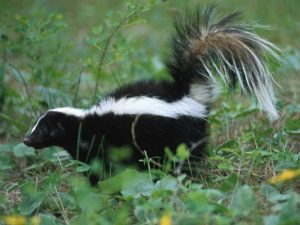Most common skunks found in the United States, Canada, and South America have black and white fur and are divided into 3 different genera. Mephitis are hooded and striped, Spilogale are spotted, and Conepatus are hog-nosed skunks. Fur color may range from black to brown to grey. The size of a skunk may range from 40 to 94 cm and can weigh up to 18 pounds.

Skunks are omnivorous creatures eating both plants and animals. They consume insects and larvae as well as earthworms, rodents, lizards, and frogs. They also consume berries, grasses, roots, fungi, and nuts. They may also act as scavengers, foraging for bird or rodent carcasses, especially left by cats or other animals. They are considered the predator of the honeybee, relying on their thick fur to protect them from the sting. Scratching the hive several times, the guard bees come out to investigate. The skunk then eats them as they try to protect their beehive.
Skunks use their powerful claws to dig holes and create their dens during the colder months and especially for the daytime when they rest. Skunks are solitary and nocturnal mammals hunting and/or scavenging for food at night although, in the colder parts of their range, they may share dens with other skunks for warmth.
Skunks commonly mate during the spring and are considered polygamous species, meaning they reproduce with more than one female. The female will search for a place to den before giving birth to her kits. The gestation period is about 66 days and when her litter is born they are blind, deaf, and covered with a soft layer of fur. The kits are weaned off of the mother’s milk after 2 months and stay with her for 1 year until they are ready to mate.
Everyone knows about the notorious foul smelling liquid that skunks spray through their anal scent glands when they feel threatened. The sulfur mixed chemical is said to smell like a combination of rotten eggs, garlic, and burned rubber. They may spray up to 15 feet in length with a high degree of accuracy and cause irritation and temporary blindness. The scent is also difficult to remove and can be detected in far distances by an insensitive human nose.
Skunks can only spray 15 times before they run out of their liquid supply. They must wait 10 days in order for their bodies to replenish more of the foul smelling chemical.







